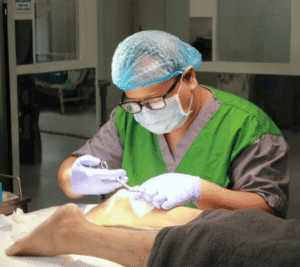Diabetic gangrene is a severe complication of diabetes that results from poor circulation and nerve damage, leading to tissue death. Left untreated, it can cause life-threatening infections and even necessitate amputation. However, orthopedic treatment for diabetic gangrene offers a vital approach to preserving mobility and promoting healing. With timely intervention from orthopedic specialists, patients can prevent complications and improve their quality of life. Understanding how orthopedic care plays a role in managing this condition is essential for those at risk.
Understanding Diabetic Gangrene
Orthopedic treatment for diabetic gangrene begins with a comprehensive understanding of the condition. Diabetic gangrene occurs when high blood sugar levels damage blood vessels, reducing oxygen and nutrient supply to tissues. This can lead to infections, ulcers, and, ultimately, gangrenous tissue.
Diabetic patients are at higher risk of developing gangrene due to peripheral artery disease (PAD) and diabetic neuropathy. PAD restricts blood flow to the extremities, particularly the feet and legs, while neuropathy causes nerve damage, making it difficult to feel injuries or wounds. As a result, minor cuts or infections can rapidly progress to gangrene, requiring specialized orthopedic intervention.
The Role of Orthopedic Treatment in Diabetic Gangrene
When dealing with diabetic gangrene, the primary goal is to prevent amputation while ensuring proper healing. Orthopedic treatment for diabetic gangrene focuses on limb preservation, infection control, and functional restoration.
Orthopedic specialists evaluate the extent of gangrene and determine the most effective treatment plan. By integrating advanced wound care, surgical intervention, and rehabilitation, orthopedic care helps diabetic patients retain mobility and avoid permanent disability. Early detection and timely orthopedic treatment significantly improve patient outcomes.
Orthopedic Treatment Options for Diabetic Gangrene
Debridement and Wound Care
A crucial aspect of orthopedic treatment for diabetic gangrene is debridement, the removal of dead or infected tissue. This process prevents the spread of infection and promotes the growth of healthy tissue. Orthopedic surgeons use specialized tools to carefully excise necrotic tissue while ensuring minimal damage to surrounding healthy areas.
Wound care is another essential component, involving regular cleaning, dressings, and antibiotic therapies. Advanced orthopedic wound management techniques, such as negative pressure wound therapy, can accelerate healing and reduce the risk of further complications.
Reconstructive Surgery
For patients with extensive tissue loss, reconstructive surgery is an integral part of orthopedic treatment for diabetic gangrene. Surgeons may perform skin grafts, tissue flaps, or bone reconstruction to restore the affected area. These procedures not only improve aesthetics but also enhance functionality, allowing patients to regain mobility.
Reconstructive techniques play a vital role in preventing amputation and promoting long-term recovery. They are particularly beneficial for individuals with foot ulcers or severe infections who need structural support to maintain mobility.
Limb Salvage Surgery
One of the most significant goals of orthopedic treatment for diabetic gangrene is to save limbs from amputation. Limb salvage surgery involves procedures that remove infected areas while preserving as much healthy tissue as possible. This may include bypass surgery to improve blood flow, tissue transplants, or bone resections.
By utilizing limb salvage techniques, orthopedic specialists help diabetic patients maintain independence and prevent drastic lifestyle changes associated with limb loss. These surgeries offer hope for those facing severe gangrene by restoring circulation and enabling tissue regeneration.
Orthopedic Prosthetics and Mobility Aids
In cases where amputation is unavoidable, orthopedic specialists ensure that patients receive proper prosthetics and mobility aids. Orthopedic treatment for diabetic gangrene extends beyond surgery to include rehabilitation and assistive devices. Custom-fitted prosthetics enhance movement and comfort, allowing patients to adapt to their new physical condition effectively.
Physical therapy and orthopedic rehabilitation further aid in restoring strength and balance, helping individuals regain confidence in their daily activities. Orthopedic professionals work closely with patients to provide personalized solutions that enhance mobility and overall well-being.
Preventive Orthopedic Care for Diabetics
Prevention is always better than treatment, especially for diabetic patients at risk of gangrene. Orthopedic treatment for diabetic gangrene includes preventive measures to minimize complications and maintain foot health.
Importance of Proper Foot Care
Diabetic individuals must prioritize foot hygiene, inspect their feet daily for wounds, and wear properly fitted shoes. Orthopedic specialists recommend customized footwear and orthotic inserts to reduce pressure points and prevent ulcers. Routine foot exams help detect early signs of infection, allowing for prompt intervention.
Regular Orthopedic Check-Ups
Early detection plays a crucial role in managing diabetic complications. Regular orthopedic check-ups ensure that any vascular or structural issues are identified before they escalate. Specialists assess circulation, nerve function, and foot alignment to address concerns proactively.
Physical Therapy and Strength Training
Maintaining mobility is essential for diabetic patients, and physical therapy is a key aspect of orthopedic treatment for diabetic gangrene. Strength training and balance exercises improve circulation, reduce pressure on affected areas, and enhance overall mobility. These therapeutic interventions prevent joint stiffness and promote long-term limb function.
Success Stories: How Orthopedic Treatment Transformed Lives
Many individuals have successfully recovered from diabetic gangrene through advanced orthopedic interventions. Orthopedic treatment for diabetic gangrene has allowed patients to regain mobility, avoid amputation, and lead active lives.
For example, a 62-year-old diabetic patient with severe foot ulcers underwent limb salvage surgery and reconstructive procedures. With dedicated orthopedic care, he avoided amputation and regained full function after rehabilitation. Another case involved a woman with diabetic neuropathy who received customized orthopedic prosthetics, enabling her to walk pain-free again. These success stories highlight the life-changing impact of orthopedic treatment.
Takeaway
Diabetic gangrene is a serious condition that demands urgent medical attention. Orthopedic treatment for diabetic gangrene provides a critical lifeline by offering solutions such as debridement, limb salvage surgery, reconstructive procedures, and prosthetics. With early diagnosis and expert orthopedic care, patients can prevent complications, preserve mobility, and enhance their quality of life.
If you or a loved one is at risk of diabetic gangrene, seeking professional orthopedic treatment can make all the difference. Don’t wait—consult an orthopedic specialist today to explore the best treatment options for healing and mobility.






